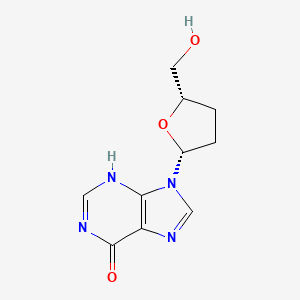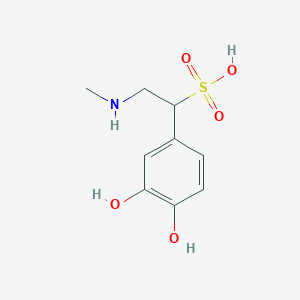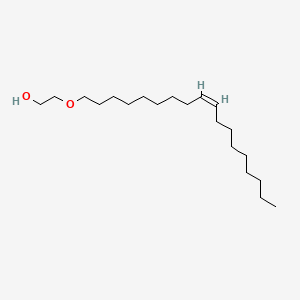
Didanosine
描述
地达诺新,也称为 2’,3’-二脱氧肌苷,是一种合成的腺苷核苷类似物。它主要用作抗逆转录病毒药物,用于治疗人类免疫缺陷病毒 (HIV) 感染。地达诺新通过抑制逆转录酶发挥作用,该酶对于 HIV 的复制至关重要。 这种化合物首次于 1975 年被描述,并于 1991 年在美国获得批准使用 .
准备方法
合成路线和反应条件: 地达诺新通过从肌苷开始的多步过程合成。关键步骤涉及选择性去除核糖部分的 2' 和 3' 位的羟基。这通常通过一系列化学反应来实现,包括保护、脱保护和选择性还原步骤。
工业生产方法: 地达诺新的工业生产涉及使用与实验室合成相似的化学路线进行大规模合成,但针对更高的产量和纯度进行了优化。该过程包括严格的质量控制措施,以确保最终产品符合药物标准。
反应类型:
氧化: 地达诺新可以发生氧化反应,尽管这些反应通常与它的药理活性无关。
还原: 该化合物本身是肌苷的还原形式,是在合成过程中通过选择性还原步骤实现的。
取代: 地达诺新可以参与亲核取代反应,特别是在嘌呤环上。
常用试剂和条件:
氧化: 过氧化氢或高锰酸钾等常见的氧化剂。
还原: 硼氢化钠或氢化铝锂等还原剂。
取代: 胺或硫醇等亲核试剂,在碱性条件下。
形成的主要产物: 这些反应形成的主要产物通常是地达诺新本身或其衍生物,具体取决于使用的特定反应条件和试剂。
科学研究应用
地达诺新在科学研究中具有广泛的应用:
化学: 用作研究核苷类似物及其化学性质的模型化合物。
生物学: 用于研究核酸代谢和酶相互作用。
医学: 广泛用于 HIV 治疗和耐药机制的研究。
工业: 用于抗逆转录病毒疗法的开发以及药物相互作用的研究。
作用机制
地达诺新在细胞内代谢为其活性形式,二脱氧腺苷三磷酸 (ddATP)。这种活性代谢物通过与天然底物脱氧腺苷三磷酸 (dATP) 竞争来抑制 HIV 逆转录酶。 通过整合到病毒 DNA 中,ddATP 会导致链终止,从而阻止病毒复制 .
类似化合物:
齐多夫定 (AZT): 另一种用于 HIV 治疗的核苷逆转录酶抑制剂。
司他夫定 (d4T): 类似的作用机制,但副作用特征不同。
拉米夫定 (3TC): 通常与其他抗逆转录病毒药物联合使用以产生协同效应。
独特性: 地达诺新在其特定的结构修饰方面是独一无二的,这些修饰赋予了它对抗 HIV 的活性。 与其他核苷类似物不同,地达诺新具有连接到糖环上的次黄嘌呤碱基,这对它的作用机制至关重要 .
相似化合物的比较
Zidovudine (AZT): Another nucleoside reverse transcriptase inhibitor used in HIV treatment.
Stavudine (d4T): Similar mechanism of action but different side effect profile.
Lamivudine (3TC): Often used in combination with other antiretrovirals for synergistic effects.
Uniqueness: Didanosine is unique in its specific structural modifications, which confer its activity against HIV. Unlike other nucleoside analogues, this compound has a hypoxanthine base attached to the sugar ring, which is crucial for its mechanism of action .
生物活性
Didanosine (ddI), a nucleoside reverse transcriptase inhibitor (NRTI), has been primarily utilized in the treatment of HIV/AIDS. Its biological activity is characterized by its mechanism of action, pharmacokinetics, mutagenicity, and clinical efficacy. This article synthesizes findings from various studies to provide a comprehensive overview of this compound's biological activity.
This compound is metabolized intracellularly to its active form, this compound triphosphate (ddATP). The conversion involves phosphorylation through several enzymatic pathways, ultimately leading to the incorporation of ddATP into viral DNA during reverse transcription. This incorporation results in chain termination, effectively inhibiting viral replication. The intracellular half-life of ddATP is approximately 12-24 hours, suggesting that less frequent dosing may be sufficient compared to other NRTIs like zidovudine (AZT) .
Pharmacokinetics
This compound exhibits low plasma protein binding (≤ 5%) and is less lipophilic than zidovudine. Consequently, it has a different distribution profile, with lower concentrations in cerebrospinal fluid compared to plasma . Approximately 40% of this compound is excreted unchanged in urine, while the remainder is metabolized into hypoxanthine and uric acid .
Mutagenicity and Toxicity
Research indicates that this compound may exhibit clastogenic effects at high doses. In vitro studies have shown it can induce DNA damage in human lymphocytes and Chinese hamster ovary cells. However, animal studies have reported no significant increase in micronuclei formation at lower doses . Notably, this compound does not appear to induce reverse mutations in Salmonella typhimurium without metabolic activation, suggesting a limited mutagenic potential under certain conditions .
Table 1: Summary of Mutagenicity Studies on this compound
| Study Type | Results |
|---|---|
| In Vitro (Human Lymphocytes) | Clastogenic effects observed |
| In Vitro (Chinese Hamster Ovary) | Induced DNA damage |
| In Vivo (Rodent Micronucleus Assay) | No increase in micronuclei at low doses |
| Salmonella typhimurium | No reverse mutations without activation |
Clinical Efficacy
This compound has demonstrated significant antiviral activity in clinical settings. A study involving 168 HIV-1 infected patients showed that those treated with this compound experienced a median decrease in HIV-1 RNA levels by -0.56 log copies/mL compared to +0.07 log copies/mL in the placebo group after four weeks . Notably, 31% of patients on this compound achieved undetectable viral loads (<400 copies/mL), compared to only 6% in the placebo group .
Case Study: this compound in Treatment-Experienced Patients
In a cohort of treatment-experienced patients with multiple nucleoside reverse-transcriptase inhibitor-associated mutations (NAMs), this compound maintained antiviral efficacy. Patients with up to five NAMs at baseline still exhibited significant reductions in viral load when treated with this compound . This underscores its potential utility even in challenging treatment scenarios.
常见问题
Basic Research Questions
Q. What validated analytical methods are recommended for quantifying didanosine in pharmaceutical formulations?
The United States Pharmacopeia (USP) outlines a reversed-phase HPLC method for this compound quantification. A standard preparation using USP this compound RS is diluted to ~LC/900, and the assay preparation follows similar dilution. Chromatographic separation uses a 0.01 M ammonium acetate buffer (pH 6.0) and a C18 column. Peak responses are compared between standard and test solutions to calculate purity (90–110% of labeled claim) . For higher sensitivity, LC-MS with deuterated internal standards (e.g., this compound-d2) improves accuracy in pharmacokinetic studies .
Q. How should researchers handle this compound to ensure safety in laboratory settings?
this compound requires precautions to avoid inhalation, skin contact, or ingestion. Use PPE (gloves, lab coat, goggles) and work in a ventilated hood. Storage should be in sealed containers at 15–30°C to prevent degradation. In case of exposure, rinse affected areas with water for 15 minutes and seek medical evaluation due to its acute toxicity (oral LD₅₀: 4300 mg/kg in rats) and potential mutagenicity .
Q. What are the key considerations when designing in vitro studies to assess this compound’s antiviral efficacy?
Use HIV-1 reverse transcriptase (RT) inhibition assays with wild-type and mutant RT strains (e.g., L74V or K65R mutations linked to resistance). Cell-based models (e.g., MT-4 lymphocytes) should measure IC₅₀ values via plaque reduction or RT activity assays. Include controls for cytotoxicity and validate results against reference inhibitors like zidovudine .
Q. How can researchers ensure stability of this compound in solution during long-term experiments?
Prepare fresh solutions in pH-neutral buffers (e.g., PBS) and avoid prolonged exposure to light or temperatures >30°C. Degradation products (e.g., hypoxanthine) can be monitored via HPLC with UV detection at 250 nm. For multi-day assays, freeze aliquots at -20°C and validate stability over 72 hours .
Advanced Research Questions
Q. How do RT codon polymorphisms (e.g., L228H/R) influence this compound’s virological response in clinical cohorts?
Retrospective genotypic analysis of HIV-1 isolates from ART-experienced patients reveals that polymorphisms at RT codons 228 (L→H/R) correlate with reduced response to this compound. Use multivariate regression to adjust for confounding factors (e.g., prior NRTI exposure). Annotate sequences with resistance scores (e.g., ANRS algorithm) and validate findings in independent datasets to account for population-specific mutation patterns .
Q. What methodologies resolve contradictions in long-term toxicity data for this compound in preclinical models?
Mitochondrial toxicity assays (e.g., lactate/pyruvate ratios in hepatocytes) and in vivo models (e.g., transgenic mice expressing POLG mutations) can clarify mechanisms like mitochondrial DNA depletion. Combine histopathology (e.g., hepatic steatosis) with metabolomics to distinguish drug-specific effects from confounding variables (e.g., comorbidities) .
Q. How can researchers optimize genotypic resistance scoring systems for this compound in heterogeneous HIV-1 subtypes?
Develop weighted scores using machine learning (e.g., random forests) trained on clinical outcomes (viral load reduction) and subtype-specific mutation frequencies. Cross-validate against global databases (e.g., Stanford HIVDB) and include accessory mutations (e.g., T69D) that modulate resistance. Ensure scores are updated as new subtype data emerge .
Q. What experimental approaches validate this compound’s degradation pathways under accelerated storage conditions?
Conduct forced degradation studies (heat, humidity, UV light) followed by LC-MS/MS to identify major degradants. Compare fragmentation patterns with reference standards (e.g., USP Related Compound A). Quantify degradation kinetics using Arrhenius modeling to predict shelf-life under standard storage .
Q. Methodological Best Practices
- Data Contradiction Analysis : Use meta-analytic frameworks (e.g., PRISMA) to harmonize disparate findings from clinical trials and preclinical studies. Stratify by variables like dosing regimen or patient CD4+ counts .
- Human Subject Research : Align participant selection with FDA guidelines (e.g., exclusion of HLA-B*5701-positive individuals to avoid hypersensitivity). Document informed consent and adverse events per IRB protocols .
属性
IUPAC Name |
9-[5-(hydroxymethyl)oxolan-2-yl]-1H-purin-6-one | |
|---|---|---|
| Details | Computed by Lexichem TK 2.7.0 (PubChem release 2021.05.07) | |
| Source | PubChem | |
| URL | https://pubchem.ncbi.nlm.nih.gov | |
| Description | Data deposited in or computed by PubChem | |
InChI |
InChI=1S/C10H12N4O3/c15-3-6-1-2-7(17-6)14-5-13-8-9(14)11-4-12-10(8)16/h4-7,15H,1-3H2,(H,11,12,16) | |
| Details | Computed by InChI 1.0.6 (PubChem release 2021.05.07) | |
| Source | PubChem | |
| URL | https://pubchem.ncbi.nlm.nih.gov | |
| Description | Data deposited in or computed by PubChem | |
InChI Key |
BXZVVICBKDXVGW-UHFFFAOYSA-N | |
| Details | Computed by InChI 1.0.6 (PubChem release 2021.05.07) | |
| Source | PubChem | |
| URL | https://pubchem.ncbi.nlm.nih.gov | |
| Description | Data deposited in or computed by PubChem | |
Canonical SMILES |
C1CC(OC1CO)N2C=NC3=C2N=CNC3=O | |
| Details | Computed by OEChem 2.3.0 (PubChem release 2021.05.07) | |
| Source | PubChem | |
| URL | https://pubchem.ncbi.nlm.nih.gov | |
| Description | Data deposited in or computed by PubChem | |
Molecular Formula |
C10H12N4O3 | |
| Details | Computed by PubChem 2.1 (PubChem release 2021.05.07) | |
| Source | PubChem | |
| URL | https://pubchem.ncbi.nlm.nih.gov | |
| Description | Data deposited in or computed by PubChem | |
DSSTOX Substance ID |
DTXSID80860902 | |
| Record name | 9-[5-(Hydroxymethyl)oxolan-2-yl]-1,9-dihydro-6H-purin-6-one | |
| Source | EPA DSSTox | |
| URL | https://comptox.epa.gov/dashboard/DTXSID80860902 | |
| Description | DSSTox provides a high quality public chemistry resource for supporting improved predictive toxicology. | |
Molecular Weight |
236.23 g/mol | |
| Details | Computed by PubChem 2.1 (PubChem release 2021.05.07) | |
| Source | PubChem | |
| URL | https://pubchem.ncbi.nlm.nih.gov | |
| Description | Data deposited in or computed by PubChem | |
CAS No. |
69655-05-6 | |
| Record name | 2', hydrate | |
| Source | DTP/NCI | |
| URL | https://dtp.cancer.gov/dtpstandard/servlet/dwindex?searchtype=NSC&outputformat=html&searchlist=612049 | |
| Description | The NCI Development Therapeutics Program (DTP) provides services and resources to the academic and private-sector research communities worldwide to facilitate the discovery and development of new cancer therapeutic agents. | |
| Explanation | Unless otherwise indicated, all text within NCI products is free of copyright and may be reused without our permission. Credit the National Cancer Institute as the source. | |
Retrosynthesis Analysis
AI-Powered Synthesis Planning: Our tool employs the Template_relevance Pistachio, Template_relevance Bkms_metabolic, Template_relevance Pistachio_ringbreaker, Template_relevance Reaxys, Template_relevance Reaxys_biocatalysis model, leveraging a vast database of chemical reactions to predict feasible synthetic routes.
One-Step Synthesis Focus: Specifically designed for one-step synthesis, it provides concise and direct routes for your target compounds, streamlining the synthesis process.
Accurate Predictions: Utilizing the extensive PISTACHIO, BKMS_METABOLIC, PISTACHIO_RINGBREAKER, REAXYS, REAXYS_BIOCATALYSIS database, our tool offers high-accuracy predictions, reflecting the latest in chemical research and data.
Strategy Settings
| Precursor scoring | Relevance Heuristic |
|---|---|
| Min. plausibility | 0.01 |
| Model | Template_relevance |
| Template Set | Pistachio/Bkms_metabolic/Pistachio_ringbreaker/Reaxys/Reaxys_biocatalysis |
| Top-N result to add to graph | 6 |
Feasible Synthetic Routes
体外研究产品的免责声明和信息
请注意,BenchChem 上展示的所有文章和产品信息仅供信息参考。 BenchChem 上可购买的产品专为体外研究设计,这些研究在生物体外进行。体外研究,源自拉丁语 "in glass",涉及在受控实验室环境中使用细胞或组织进行的实验。重要的是要注意,这些产品没有被归类为药物或药品,他们没有得到 FDA 的批准,用于预防、治疗或治愈任何医疗状况、疾病或疾病。我们必须强调,将这些产品以任何形式引入人类或动物的身体都是法律严格禁止的。遵守这些指南对确保研究和实验的法律和道德标准的符合性至关重要。















